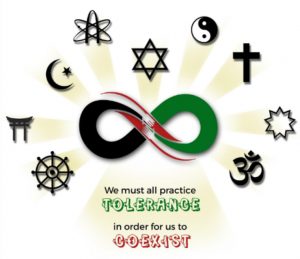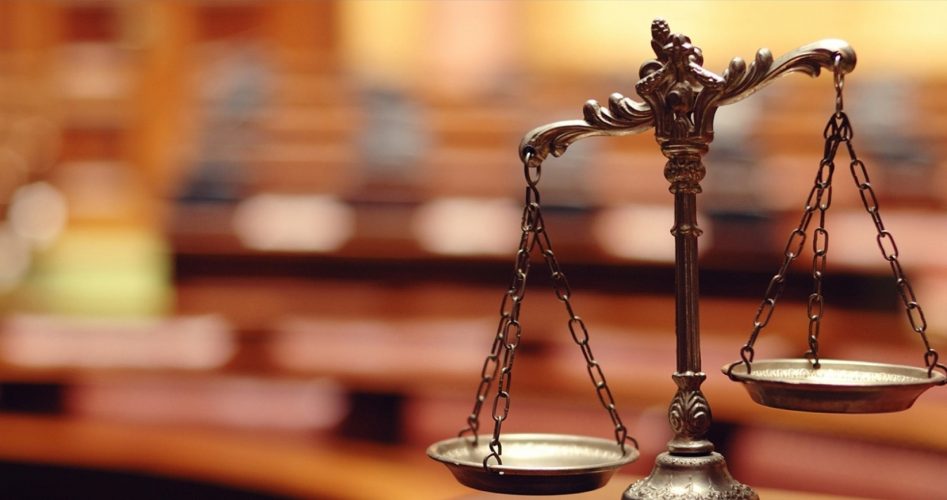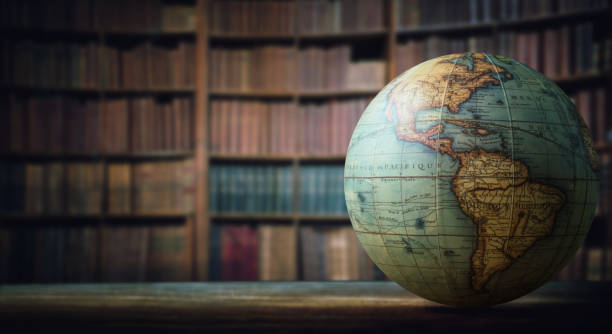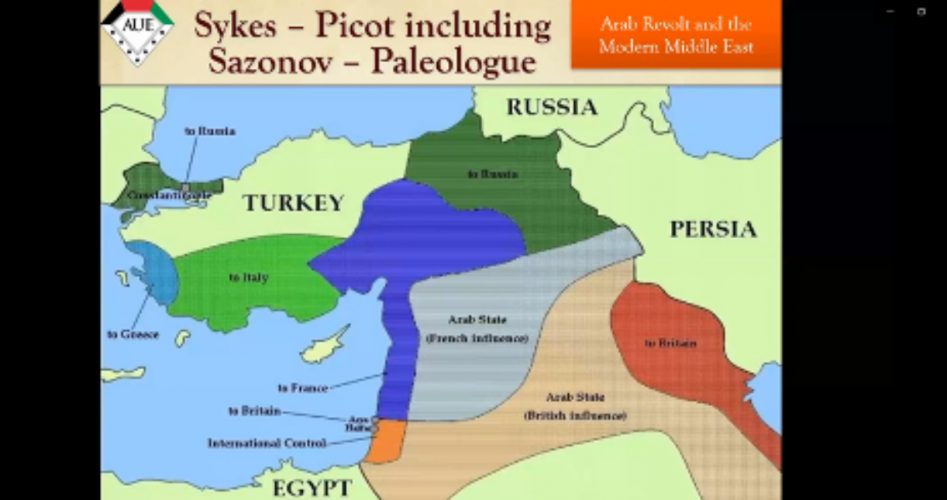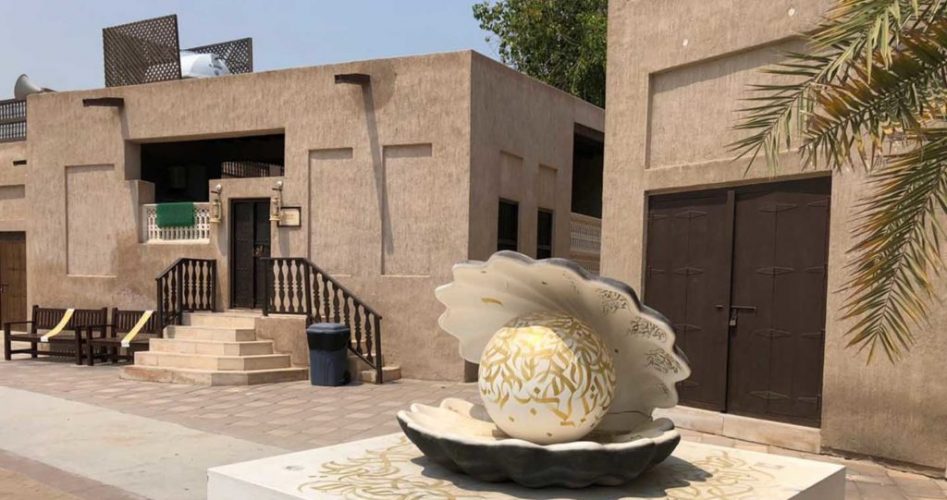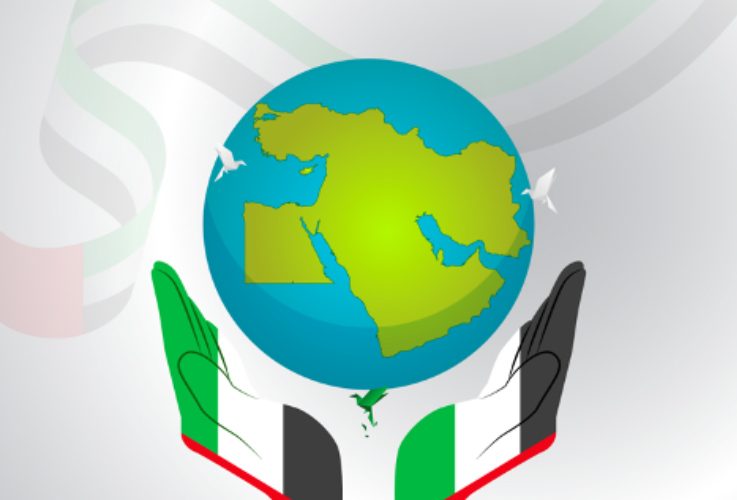Under the supervision of Faculty Ms. Casiana
Social and Behavioral Sciences
Guest Speaker: Ms. Jessica Zakhour
Under the supervision of Faculty Ms. Karoline
Ms. Zakhour is an Associate Lawyer at TCC Law Firm in Beirut. In addition, she was appointed as a Participating Lawyer at Legal Advice Middle East in Dubai and a Participating Lawyer at Housing Monitor (Public Works Studio) – www.housingmonitor.org. Ms Zakhour additionally holds the position of Legal Consultant at the Embassy of Brazil in Beirut, Sin el Fil .
The questions to be discussed :
1. What is a constitution? What is a law? What is the difference?
2. What are the main roles of a constitution?
3. What are the types of constitution?
4. What are the two types of Laws followed ( common and civil)?
The presentation was on Monday October 12, 2020. A certificate was awarded.
Below are some of the pictures taken during the session and sample student reports.
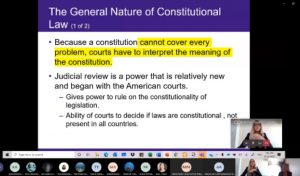

Guest Speaker Reflection Esra Abdulqader – 171410056
On October 12, 2020, we interviewed our guest speaker, Mrs. Jessica Zakor, lawyer and Legal consultant at the Embassy of Brazil. We discussed the difference between statutory law and constitutional law, and we learned about the constitution and its different types, in addition to the legal systems in the world. What is the Statutory Law? The statutory law is a law that is formulated and approved by the legislative councils or parliament. It is known as an ordinary law. This type of law has the advantage that it can be changed from time to time in an easy way by legislators. With the continuous evolving of societies and depending on the circumstances in which societies may evolve, laws may require changing. this is the reason for the existence of this type of law because ordinary laws can be changed easily. For example, when the COVID-19 pandemic occurred in the world, some countries began enacting laws in an attempt to control the spread of the pandemic among members of society, by which there was a law to curfews for certain hours, and to impose fines for individuals not following precautionary measures and social distancing such as wearing masks, leaving distances and preventing social gatherings. All of these laws are temporary or statutory laws based on what society is going through and what it needs to control the pandemic. It is possible that these laws may be canceled at a later time or amended according to the community’s needs. What is the Constitutional Law? Constitutional laws are the rules and provisions mentioned in the constitution of the state. This type of law is difficult to change because it represents the basic rules for any state. Running head: KINGDOM OF SWEDEN What is the Constitution? The constitution is that document that carries all the rules and customs of any state in addition to the system of government, and the principles of government and its administration, whether written or not. It is the highest law in the state and no other laws can contravene them, that’s why constitution laws are very difficult to change. In order for any state to be established, it must draft a constitution that defines its strength and principles. The constitution reflects the identity of the state in terms of language, religion, culture, etc. The constitution is the one that guarantees the rights of citizens and defines their duties towards their homeland through the laws and provisions of the constitution. Types of Constitution: Federal Constitution In the federal constitution, power is divided between certain parts of the country, so each part has an independent government with its own laws set by the legislative bodies, an example is the United Arab Emirates. Unitary Constitution As for the unitary constitution, there will be a central government that has a supreme legislative body to lay down laws for the entire country. An example is the United Kingdom. Legal Systems: The only two legal systems adopted around the world are the common law system and the civil law system. During the lecture, Mrs. Zakkour quoted a quote from the English philosopher Jeremy Bentham who lived under the common law legal system, to explain the difference between civil law and common law, and said: “The power of the lawyer in the uncertainty of the law.” This quote applies to common law to a large extent, but also applies to civil in some way. Running head: KINGDOM OF SWEDEN Civil Law Civil laws are codified laws, and they are sometimes referred to as “code of law.” The origins of civil law came from Roman law. It is a set of legal principles that include all the rules of the judiciary and courts, such as penalties and sentences. The role of the judge in civil law is represented in investigating the case and directing charges in addition to issuing judgments, but all of this is within the framework of specific legal rules and principles. Common Law Common law is not codified, which means that there is no complete compilation of legal principles, unlike civil law, which contains a set of legal rules that are followed by courts and judges. In common law, judges rely on judging precedents or judicial decisions taken in previously similar cases. These precedents are recorded and documented as case laws through legal reports. Conclusion It was a lecture full of valuable information on the issue of the constitution in its various types and legal systems around the world. I was very happy to learn about these differences between the types of laws and the importance of the constitution in defining the identity of states.
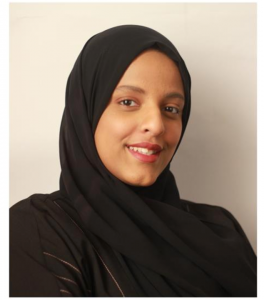
a case study by Abdulrahman Mohammad Al kayat under supervison of Dr. jihene
In 1914, a paper called (Narcissism: An Introduction) was issued by the infamous Sigmund Freud. he suggested a very complex set of concepts in which he indicated that narcissism is linked to whether a person’s libido (energy that sits behind the survival instincts of every individual) is pointed towards a person’s identity or towards other individuals externally. He believed that all of the inward libido was directed by infants, a state he describes as primary narcissism.
There was a fixed amount of this energy in Freud’s model, and to the point where this libido was directed outwards toward connection to other indiv’iduals, the amount available to one’s self would be reduced. Freud suggested that individuals faced decreased primary narcissism by “giving away ” this love, and he understood that finding love and warmth in life was crucial to retaining a feeling of fulfillment in order to replenish this capacit y.
Furthermore, in Freud’s theory of personality, as a child cooperates through the external world, a person’s sense of himself develops and starts to study societal customs and social prospects that are leading to the expansion of a perfect ego, or a flawless view of himself that the self-image attempts to accomplish.
The notion that this passion of an individual’s own self can be moved to another individual or object is another important element of Freud’s theory. Freud indicated that individuals faced weakened main narcissism by sharing love with people, causing them to not being able to foster, protect and protect themselves. He considered that having affection and warmth in exchange was crucial in order to replenish this capacit y.
In another theory of narcissistic, Akhitar and Thomson (1982) have wanted to carry the distributed literature on narcissism into a comprehensive outline in a sequence of predominantly insightful credentials, including their characteristic open and secret features in 6 parts of psychosocial operation. Akhtar (1992) indicates in a recent brink that narcissists seem openly grandiose, manipulative, seductive and expressive. Nev’ertheless, they are, covertly, doubt- ridden, jealous of others, corruptible, constantl y bnred, and unable to love.
Due to the inequality that occurs between countless narcissistic people among their intrapsychical suspicions, Akhtar’s plan for separating the open from the secret is a very useful plan.
Ciunderson is another significant contributor to the literature of narcissistic personalities. “He includes several principles in summarizing the characteristics of the narcissist
(Gunderson 1990): ” patients with narcissism are generally gifted people that have continuous stages of fruitful academical work or artistic accomplishment, This is often a basis of their feeling of dominance, also it’s a purpose to what makes them more suitable to appear in isolated rehearsal environments than in either organizations or hospitals.
Narcissistically traumatized patients have told stories where the y responded to the opinion of other people’s bitterness towards them with hostility y and suspicion. They believe that other people’s bitterness of t hem is because of jealousy. They believe that other individuals have planned to hurt them to ruin their effort, diminish their successes, or disparage them behind their back because of their jealousy.
Even Though there are various levels and types of narcissism, research for decades has centered primarily on typical exhibitionist narcissistic people seeking the public eye. those are called (grandiose Narcissists), grandful narcissists that are popular figures and identifiable in movies. They are portrayed in the Analytical Numerical Guide of Psychological Syndromes as a narcissistic personality syndrome.
We all can notice those attention-seeking, charismatic outgoing people whose egotism and audacity are shameless and disgusting at times. Usually they are self-absorbed, aggressive, insensitive, manipulative, controlling, and aggressive, some are even abusive at times. those types of narcissists feel that they are above everyone else.
Another type of narcissism only recently named, (communal narcissists), it is even more challenging to distinguish. They value affection, friendliness, and connection. Through friendliness and compassion, they see themselyes and want to be viewed by others as the highly trustworthy and caring individual.
Like a grandiose narcissism, they are outgoing. While the grandiose narcissism s intend to become regarded as the cleverest and truly potent, a communal narcissists aims to be regarded as the most supportive and giving. The vain unselfishness of Communal Narcissists is not less egoistic than the grandiose narcissism. Both narcissistic types share related reasons for grandeur, regard, power, and authority, although each type uses distinct actions to attain them. lt’s a bigger drop when their hypocrisy is found.
A third type is called (Vulnerable narcissists) which are less well known compared to other t ypes, they are self-centered entitled, unfair, de›’ious, and hostile, similar to their grandiose kin, although they are worrying about critique significantly to a point where they back away from attention. People of both kinds of narcissism frequently are in need of independence and are self-isolated and incapable of mastering their atmosphere. The Vulnerable narcissists, however, experience these things to a significantly larger scope than the grandiose.
Due to their brutality and aggressiveness, (malignant narcissists) are regarded to be at the severe end of the scale of selfishness. Obsessed, morally wrong, and inhuman, they are. In generating chaos and putting people down, the y find satisfaction. These types are not exactly grandiose, extroverted, or neurotic, these narcissists are closely linked to being anti-scicial and psychopathic.
A narcissistic pervert is someone who during his childhood actually faced trauma, and this trauma made him to be detached from his body in order to continue surviving it. Therefore, he is someone who works in complete rejection of his own body, emotions, feelings, essential needs, and who also rejects his mind, his creative thinking, this idea that includes psychic tensions and questioning.
A narcissistic pervert operates without compassion for others and never doubts himself.
These are individuals who through their family interactions with either physical or verbal aggression, have suffered from trauma. The narcissistic pervert detached himself from his own “emotions” in order to protect himself.
The victims of narcissistic perverts are usually found isolated. Naturally, since they lose self-confidence, but also for the reason that their pervert often undermines the effort of the nearest and dearest of the victim. Isolation is obviously not the solution to returning to the ordinary life that the victim used to have.
The victim must prove to him that the contradictions he uses do not fool her. The individuals targeted should not be isolated. the victims need to restore their understanding of their values, abilities and self-love. The victims must also realize that the pervert is not superior, but he is in agony, a fact that prevents him from his power. lt must also be known that it is in fact impossible to accomplish the greatest fear he has, that of destroying her sense of existence.
A different strategy to defend yourself from the pervert is to respond to his manipulation, a method that comprises of replying to everything the pervert says indifferently. This is goingassist the victim to recover her inner harmony and put an end to the stream of justification between her and the pervert.
References
- Freud, S. (1957). On narcissism: An intrrxluction. ln The Standard Edition of the Complete Psychological Works of Sigmund Freud
- Akhtar S, Thomson JA Jr. Overview: narcissistic personality disorder. Am I P psychiatry. 1982
- Gunderson JG, Ronningstam E, Bodkin A. The diagnostic interview for narcissistic pat ients. Arch Gen Psychiatry. 1990
- Houlcroft, L., Bore, M., & Munro, D. (2012). “Three faces of Narcissism.” Personality and Individual Differences, 53: 274-278.
- Bednar, R. (2016, December IS). Narcissistic perversion: 13 signs to detect it

Guest Speaker Mr. Josep Coll
Under the supervision of Faculty Ms. Karoline
Knowing Mr. Josep Garcia Coll’s extensive knowledge about the Middle Eastern region and the role of civil societies, he was invited as a guest speaker in Introduction to Political Science class to talk about the role of Civil Societies in building peace.
Mr. Coll is originally from Valencia, Spain. He has a Master’s degree in Peace, Conflicts and
Development that was preceded by a BA in English Philology. His initial training and experience
were as a high school teacher, although through his professional career, he has combined work in
formal and non-formal education settings. In the summer of 2011, he worked with the
organization Windows-Channels for Communication designing peace-building workshops for
Jewish and Palestinian youth. After this, he spent a year at the Corrymeela Community in
Northern Ireland, where he designed, coordinated and facilitated Conflict Transformation and
inter-religious dialogue workshops with youth, members of the civil society, security forces and
paramilitary groups. Afterward, he spent a year in Burundi working with Search for Common
Ground (SFCG) supporting the design and evaluation of dialogue workshops for the prevention
of political-ethnic violence. He was subsequently contracted by SFCG as a trainer in Conflict
Transformation and Human Rights for community leaders and paramilitary groups in Central
African Republic.
He lived in Lebanon for a year, where he worked as Communications and Project Officer for
SFCG. Here he coordinated a Conflict Resolution project for Syrian, Palestinian and Lebanese
youth and facilitated some training sessions with university students and youth.
He is currently studying a Master’s Degree studies in Research on Behavior and Cognition at the
University of Barcelona, focusing on violence risk assessment systems.
The questions that were discussed:
1. What is a civil Society?
2. What are NGOs?
3. What is the role of Civil Societies?
4. What are the means to achieve the goal of civil societies?
5. Examples from around the world!
It was a fruitful class discussions where Mr. Coll shared his expertise on the topic with the
students.. I believe that his contribution to this field is unparalleled and a discussion on this topic
was of great benefit to the students.
The presentation took place on November 18, 2019 . A certificate was awarded.
Below are some of the pictures taken during the session and sample student reports.

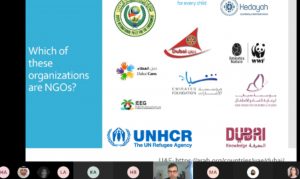
Massa shebli – 191410033
Report about the lecture
(Guest speaker)
Mr.Coll discussed what is the meaning of civil society and their roles. The meaning of civil society is a community of citizens linked by common interests and collective activity. They make important contributions to civil society. The meaning of NGOs and examples of them were also explained. NGO is a non governmental organization. And it is made for a goal, he M.r Coll stated the example of helping African poverty and how it is very helpful. And then some examples of NGO in UAE were stated. And he also explained the ways to achieve the goal of civil societies. In the lecture the steps to form an NGO strategic planning was stated. Firstly, the definition is formed then why it is formed or it will form. Secondly, the motto is formed, which is a sentence that summarize the concept. Then the focus, which is where it work. Then the mission and vision, the mission is the goal on the short run, but the vision is a big and long goal. Eventually, the sustainability plan is made and at the end the formalization of the NGO. This lecture was very helpful and we learned more about NGO and examples of them from all around the world.
Haneen Baoom – 201310006
In the beginning Mr. Coll started talking about what is civil society what they’re doing, and he started by talking about the sectors of the general society which are:
Public: which is rolling by the government
private: means business
civil society: as Mr. Coll explain its neither privet or public because it’s included facilities that works for the society benefits but they don’t get any profits or political earnings
And as what I understand from Mr. Coll, we can define civil society as: an independent individual or it can be organization from the government, and they exercised their rights of freedom speak and ossification such as: NGOs, foundation etc.
And it can be guided by religious beliefs or particular cause
What is the role of civil society?
As Mr. Coll mention civil society is very important at this period of time, all is civil society is working for is the humanities, it’s their first goal, such as Red Cross or habitat, they are here for helping people.
What do we mean by NGOs?
First of all, NGOs it came under the name of civil society organizations, and it stands for none- governmental organizations which means an independent facility cares about human needs and causes
And NGOs is relying on donations and from individuals because it’s not supported by the government so there is no profit of it.
He explained how is NGOs can get money from many recourses, and how can we make between NGOs and IGOs
How NGOs cares about human cause and their main goal to maintain peace in world
Guest Speaker Eltion Meka – World History
Under the supervision of Faculty Ms. Karoline
3 reflective papers
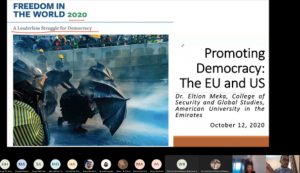
Guest Speaker: Dr. Eltion Meka – World History-ASC 203
Topic: Promoting Democratization after WW2: Where did we reach?
Date and Time: October 12, 2020 at 5.40 pm-6.45 pm ( UAE time).
Dr. Meka was invited to World History course to talk about how Europe and U.S promoted the age of democratization after WW2.
Student Reports:
Mohammad Khalifa Mohd Abdulla Yemai
Guest speaker
Our guest speaker Dr. Eltion Meka explained what Freedom House is, which is a US based think tank that specializes in matters of democracy and freedom and every year they value democracy around the world to see where the world is and what pollical institution is dominant.
Dr. Eltion Meka showd us a graph showing the years in which democracy started to promote it self financially in the world you can see the intervals from 90’s to 95 then it goes down and jumps again in 98 then in 03 it has an extreme rise till 2012. And another graph of the six subcategories from FO Democracy Progs., NED, Civil Society, Political Competition, Good Governance, and Rule of Law/HR.
Dr. Eltion Meka explains what the Democracy promotion are; the process by which an outer actor intervenes to establish democratic gov in a country or stat, this is like the article 1 of The International Dimension of Democratization Consent part of Who is promoting, How are they promoting, what are they promoting and What effect are they having are important aspects of Democratization Consent because it will have a ripple effect that can be good or bad later on in the following years.
Dr. Eltion Meka talked about models of democracy are being promoted and gave example of Consesnual and majoritarian; presidential and parliamentary. Dr. Eltion Meka mentioned this because when you promote democracy you have to keep in mind what type of democracy are you promoting and what model will be ideal for the society that you will promote democracy. You have homogenized society and heterogeneous society. In a heterogeneous society everyone wants power in government decision making and you need to be careful because it might make society or country worse than helping it.
Dr. Eltion Meka start to talk about why we should be scared about democracy is dropping because you will need leader to represent democracy and when Donald trump is elected president and not showing regards to democratic ideal, and other countries look up to US as the true democracy as mentioned in article 2 by Prof. Paul Cartledge as US and UK have different democracy and US is the most idealized version. When the global power fails to abide by democracy domestically it will send a wrong message to the world and democracy power struggles and drop favorability, which result in other country shift to other style of government.
Dr. Eltion Meka further explains during the class Question and Answer segment about Authoritarian regime and democracy. Dr. Eltion Meka further explained that in a democracy if the leadership is bad you can resolve it in a peaceful manner by reelection in the next term, while in an Authoritarian regime it will be in a non-peaceful manner through civil war or operation. Dr. Eltion Meka is clear in mentioning that he is not here to prescribe a form of government but to explain the history of and evolution of global politics.
Dr. Karoline asked in class about the future of promoting democracy and who will be the main promoter Dr. Eltion Meka gave an answer to the question saying that the leader of promotion is EU because they are the GCC of members stats and is clear who will join them and they need to be a democracy. Because of that EU is Democracy that has and shows influence in the world and will be the current democratic leader for promoting. US can still fulfill this roll but it depends on who is elected next month. If trump is re-elected the US as a promoter for democracy will be in the back seat.
171010001 Reflection — Asma Abbas Ali Haji-
Doctor Eltion Meka talked about the international promotion of democracy and the present status in the world with reference to the different empires. He further emphasized on the relevance of democracy in the present times with reference to the context of the EU. He deliberated the concept with the aid of PowerPoint presentations inculcating news articles, journal cutouts and informative content. Voting for selection of governing bodies and political parties are often considered as the changes demanded by the citizens that can be referred to as democracy of choice. Furthermore, the professor justified as to why leadership is crucial for democracy especially in recent times referring to the historical events such as the end of WWII. US and UK enforced democracy in Germany and Japan laying stress on the fact that democracy is known to prevail for ancient times.
The professor helped me understand how countries are rated on scores based on their extent of being democratic in the global scale (0-7) where 0 indicates a country having no democracy and 7 being highly democratic. Moreover, I learnt that democracy had been countered since 2005. I further comprehended that democracy is an individual’s choice and cannot be forced for adoption. I adore how well the professor clarified the fundamental concept of democracy and its actual essence along with highlighting its role in upgrading the society. However, given the vivid expertise that the professor has an expertise on the genre, I would be interested in learning more about the emergence of democracy with assistance of case studies of different countries.
I understood that democracy states the government by the people. In this process, the government in which the supreme power is provided to the people where a representative of an area is elected by citizens. Further, the process involves all the elected representatives choosing a head of the nation/region by electoral votes. So basically it can be comprehended that democracy helps to understand that people can make their path of progress by choosing their preferable representatives. If a representative failed to perform ideally, then citizens might be altered with a suitable alternative. Hence, this topic provides me with an effective knowledge about how citizens exercise power to directly elect their representatives which makes a country more powerful and progressive. Consequently, promotion of democracy required.
Freedom of political expression and speech of reporters is important through which voters are well informed about their representatives and government helping them cast their vote according to their own interest. It has been observed that most of the countries such as Syria and Yemen suffer from the dictatorship where citizens of those countries suffer a lot from their respective presidents and failed to get recognition globally due to their poor economy. Therefore, democracy becomes a significant aspect in the world where this power makes those representatives and the government more accountable.
191010001 Reflection – Mais Obaji
Dr. Meka introduced the term democracy and how it was promoted throughout the years. The presenter’s speech had a great impact on my knowledge of what happened in the world and especially after we studied the structure of different empires (Chinese, Americas, Byzantine, and Islamic) throughout the World History course. The speaker talked about the dramatic changes that occurred in 2008 and how people have different views of the term democracy where some see electing a person means that he/she is representing their interest which is known as changing the government. The other category thinks that democracy is to overthink the political system where you keep changing between authoritarian and democracy regime. It was great to know about the history of democracy and the role of US and EU in promoting democracy as he emphasized on the role of leadership in democracy promotion nowadays. He talked about the impact of forcing democracy and how people should act towards it. I knew that countries are ranked (0-7) based on their level of being democratic in the global measure where 7 represents a country of a higher democracy. It will be great to know that countries can be promoted when citizens elect their leaders to help the regime becomes more liable.
The professor was able to explain the essential perception of democracy and its authentic core beside illuminating its position in advancing the society. He explained the process of electing a representative to represent the country and there will be a leader who guides these representatives. We can understand that powerful individuals in any society can choose to develop and proceed in their countries as they appreciate the importance of promoting democracy. Dr. Meka discussed the positive and negative impact of governments having their citizens elect their leaders where people will work hard with the regime to overcome difficulties such as economic struggles. I would love to hear from the doctor about the development of democracy throughout the history, how can we as citizens help in its promotion, and how did it change governments to be able to rule the world with its power lately. I wanted to know also about the impact of implementing courses about the promotion of democracy in our educational systems and how it will help in emerging our countries.
The Middle East History Course with the guest speaker Kleanthis Kyriakidis
The Balfour and Sykes Picot Agreement: Its effects in the Middle East
Under the supervision of Faculty Ms. Karoline
Guest Speaker: Dr. Kleanthis Kyriakidis
Middle East History ASC 204-1/2
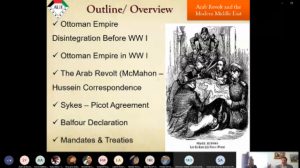
Topic: the Balfour and Sykes Picot Agreement: Its effects on the Middle East
Date and Time: October 11, 2020 and October 12,2020
Students’ Reports:
Saad Alsaadi
191420033
Guest speaker:
Dr. KK mainly discussed the Sykes-Picot agreement, the Arab revolt, and its consequences on the modern Middle East. KK argued that what defined the Middle East today was mainly because of the McMahon – Hussein correspondence, the Sykes-Picot agreement, and the Belfour declaration. He went into brief details about the causes of WWI which included colonial rivalry, arms race, militarism, nationalist movements, as well as socioeconomic problems. The immediate factor that led to WWI was the assassination of Archduke Franz Ferdinand, heir to the Austro-Hungarian throne in 1914 by Gavrilo Princip. Austria-Hungary declared war on Serbia, which led to Russian mobilization, which later led to Germany declaring war on Russia, which in turn led to France aided by Britain invading Belgium.
The ottoman empire, during WWI, sided with Bulgaria, Austria-Hungary, and Germany against pretty much the rest of the world. The Ottomans sided with these powers and recruited the power of Jihad against the Allies. The Allies were threatened by this move because they were in control of the Dardanelle straits which would cut off Russian trade routes and supply lines, the Germans were involved with British interests in India and in Iran, and that the allies were afraid that the Muslims would follow their Ottoman leaders and fight against them now that Jihad was declared. The ottomans had to deal with the allies from four fronts: Palestine and Syria, Iraq, Gallapoli, and the Caucasus. B
British colonialism of the Arab region was more about their control of the region’s economies and politics, mainly focusing on the foreign policies of these countries to protect the British’s best interests. In order to gain support of the Arabs to secure their win against the Ottomans, the British corresponded with the Grand Sherriff of Mecca, Sharif Hussein and in these correspondences they said that they would help the Arabs establish their own sovereign Arab states without any sort of intervention if they received their help defeating the ottoman empire. The British did not stand by their offer, which is evident by their secret signing of the Sykes-Picot agreement. The Sykes-Picot agreements was a secret agreement between Britain and France with the support of Russia; it was an agreement that would divide the control of the Arab world amongst them in case the Ottomans were defeated, and nations were divided in terms of both direct and indirect control. During these agreements, the British also corresponded with the Zionists because they needed them on their side for their financial and political support. The British foreign secretary Charles Balfour indirectly promised the Rothschild, a British-Jewish leader at the time that they would establish them a home in what was then the land of Palestine. This was again against the Sykes-Picot agreement, because Jerusalem was supposed to be an international zone that is not under the control of both Britain and France.
I believe that Dr. KK’s presentation was truly eye-opening because it focused on how the British, the French, and the Russians capitalized on a region by spreading propaganda and rallying support to liberate them, while at the same time having their own secret agreements to protect and further enhance their personal financial and political gains.
Reflection about Guest Speaker: Dr. Kleanthis Kyriakidis Bothaina Oudaa – 161410050
To begin, it was a great lesson with our guest speaker Dr. KK who introduced it to a topic that we all know about or heard a bit at least, but he presented it from a different angle with different important details that I was not aware of and many of my colleagues. First, we were introduced to the Ottoman disintegration before WW1, and how we have the curving of nowadays ME which impacted the borders and mentality of those affected areas. He clearly mentioned that many people thought that all ME was under the Ottoman Empire, and that is not true because part of North Africa, Balkans, and big part of the Gulf was not under their control. Next, we spoke about WW1 “the Great War” and how it is a big event in history that was caused by many reasons that will be discussed in my colleague’s reflection. However, the Ottoman Empire in WW1 decided to side with Central Power against the 3 big allies who were British, French, and Russian. It fought in four fronts against these allies.
We also discussed the promises that were made to Arabs by the British, and the Zionists contribution in Balfour Declaration which is a divergent of Sykes-Picot (promising the Jews a home in the ME) and how Israel was created after WW2 not one. The British used the word “national home” not country in the declaration which was dated on November 7,1917 which was vaguer than Sykes-Picot as described by Dr. KK.
Finally, the Central Power lost the war, and Russia withdrew from WW1 because of its inner revolution. We have the Americans intervening which changed the balance of the war, and we got introduced to Mandates which are territories that the British claimed they are not there to “colonize” but “help” which is a direct lie from my opinion and I believe many as well!
Reflection about Guest Speaker: Dr. Kleanthis Kyriakidis
Mohammad Omar – 181410069
In continuation with my colleague Bothaina, our guest speaker Dr. KK gave us a clear vision of the Ottoman Empire role in ME before and after WW1, as well as the revolutions of ME Arab countries. We discussed in depth many agreements and treaties including Sykes Picot, Belfour Declaration, Lausanne Treaty, and the Treaty of Severs. Interestingly, the WW1 (1914-1918) was caused by various reasons including colonial rivalry (for example entire Africa was colonized and everyone wanted a share of the “big pie”), militarism, very complex alliances, and nationalist movements like the Arab nationalist movement which was fueled by the British as Dr. KK explained. In addition, Imperialism was an important cause as well, but the main cause which triggered the whole war was the assassination of Archduke Franz Ferdinand in Balkans as Dr. KK mentioned. Also, the Sykes-picot divided League of Nations mandates which included Syria, Lebanon, Iraq, Transjordan, and many other Arab countries.
Finally, Treaty of Severes apart of Sykes-Picot was signed by Ottoman Sultan, and a big area of the Ottoman colonization was taken from them by the Greeks, Italians, and of course British & French. So truly there was an intervention of many countries to take the goods and resources of these Arab countries within Middle East, and they shaped the way it is divided recently!
A virtual tour at the Saruq Al Hadid Museum during the pandemic with the Anthropology students
Under the supervision of Faculty Dr. Leslie
Sarooq Al – Hadid
by – Elhusein Taha
Sarooq Al – Hadid museum is an archaeological site in southern Dubai. It was discovered in 2002 when his highness sheikh Mohamed was flying over in a helicopter and saw very strange black domes. After noticing the landscape his highness came back with experts and they dug to discover what was under the sand. What was discovered was artifacts from two different times which are the stone age, and the iron age.
The minerals used at the time where iron and copper it was the source of mineral, they mined from mountains and only twenty percent of the landscape has been discovered. The artifacts that have been discovered are swords, daggers, jewelry, war gear, axe head and arrow heads. The most interesting discovery found are the pots that are designed with snakes. Snakes where not known how to be dealt with in times of a snake poisoning a civilian, so they were praised because of that situation as antidotes did not exist and to this day pharmacy’s carry the logo with the shape of a snake. These artifacts are labeled with its year of finding and what it is made of and this information is usually gained after analyzing each artifact. The Greatest mystery about sarooq al – Hadid is the fact that the area showed so much signs of life before with the fossils of animals such as onyx, deer’s and many other animal fossils yet not a single human fossil was discovered but it was discovered the area was mainly for trading.
Knowing the history about the people who walked the earth before the people of today is a very important thing as anthropology teaches us every aspect of human existence. They show us difference of how life was lived by the day as in seeing the diverse ways of seeing the world and to also give us answers to our questions about ourselves and our past, present, future by connecting everyone from around the globe to their origins and cultural heritage. Some of the ways to raise awareness are heritage awards, heritage walk, and heritage trails which give a vast amount of knowledge and admiration to not leave what’s left behind as history and carry it forward as part of every individuals lives.
Introduction to Anthropology
by- Sara Issa
Saruq Al Hadid is an artifact museum located in Dubai and is considered one of the most important historical sites in the United Arab Emirates. The site was discovered by Sheikh Mohammed Bin Rashid Al Maktoum, the ruler of Dubai, when he was flying across the desert in his helicopter and noticed unusual formations in the sand dunes, as well as black dots scattered across the sand, which was found out to be “slag” – the waste of smelted metal ore. The showcase in the museum starts from the Stone Age (5,000 BC), continues through the Bronze Age (4,000 BC), and ends at the Iron Age (3,000 BC).
There are many different artifacts on display at the Saruq Al Hadid Museum, such as ceramics, arrowheads and axe heads, knives, fishhooks, jewellery (including a gold ring that the Dubai Expo 2020 logo was inspired by) and fish, camel and oryx bones. The artifact that intrigued me the most, however, was something fittingly named the “mystery object”. It was given this name due to the amount of time it took to figure out what it was even for. The object itself is made of metal and is said to have been used for both humans and camels, and for two reasons each. For humans, the first use/reason is it was used as weights for them to lift and build their strength, and the second one was to protect themselves. For camels, on the other hand, and these are the uses that I find more interesting, are to slow the camels down (they would be attached to a camel’s ankle), and also to be able to identify whose camel was whose. The latter reason is the one that I find most fascinating, because it’s almost like an ancient version of a collar that humans put on their pets which to me is funny to think about. It also really does further prove the fact that humans have always had this sense of ownership over things, which has been indicated in some of the first pieces of art thought to have ever existed and has continued to show throughout the different ages in time.
This can then of course be related back to anthropology, and is actually an important aspect of the subject, as since it is the study of humans and human societies, cultures, and their development (past and present), the many artifacts show said development, and allow us to understand how we as humans have not only stayed the same (just in more updated, modern ways), but also how we have grown, developed and evolved as a species – individually and collectively as societies. Also, the fact that the museum holds so many different artifacts of different types, it’s almost as if it gives us a ‘holistic view’ of the time periods that the artifacts represent, as we are able to see so many different branches or types of items that are all used for different things, so when we see them all together, we are given a wider view of what society and what people could have been like at the time and what they did.
The Saruq Al Hadid Museum does well to raise awareness and also to just inform people on the history of the UAE’s culture and society. One way they do this is via the artifacts on display. For example, they have items made from materials such as olivewood and pinewood, which indicate early relations/trade links with Levantine countries, as well as items made from metals not found in the Gulf, such as tin, and ceramics/pottery that are linked to Mesopotamia (modern-day Iraq). In fact, for this reason, all of these various artifacts are linked as factors behind Dubai’s present-day role as a global trading hub. The staff at the museum are also a huge influence on spreading the history and knowledge about the site, as well as the interactive experiences offered when visiting the museum, such as archaeological “digs” that visitors can take part in, which are all very important, as the people of the UAE have the right and should be able to learn and understand the history of their people and society.
ASC 102 – Introduction to Anthropology
by- Dunia Saadeh
Saruq Al Hadid is a museum that is located in Shindagha and was previously owned by SHK Jumaa Al Maktoum. Saruq Al Hadid is Arabic for ‘the way of iron’. The site was discovered after his highness SHK Mohammed bin Rashid was flying in a helicopter and found strange dunes. When specialists were brought, they found out that those were valuable artifacts. The eras that the museum own their artifacts from are the Stone and Iron Ages. Artifacts from the Stone Age include manufacturing tools, basic arrowheads, and other tools. The other stage shows the artifacts from the Iron Age as they have discovered that the site was a place of iron ‘factory’.
The black stones or dunes that were discovered were actually slags which are wastes from melting the iron. The museum found many tools, however, they focus more on weapons. They have showrooms of daggers and swords made from iron that have been found in Saruq Al Hadid. What is very interesting is that those weapons have animal shapes crafted in them. Specialists think that either those designs were inspired or the weapons came from India; as those animals didn’t live in the region. What reinforce the fact that Saruq Al Hadid was a factory is that they found more than 5,000 metal arrowheads. Moreover, they have found mysterious objects that look like not finished bracelets. Specialists believe they were put on camels’ legs to help identify their own camels from others. Now, what is more mind blowing is that archaeologists did not find any human bones or scripts, they only found the artifacts. So, they know nothing about the people that lived there, they only have their artifacts.
Saruq Al Hadid was also a focal or center point where people went there to work on the site, sell their goods, and then go back to their region. Potty were found that had Bahraini designs. Moreover, there are seals that were used as stamps. Many artifacts had snakes designed all around them. In that age people were afraid of snakes. So, they believed that if they draw it then it will protect them from snake poison. Moreover, jewellery like necklaces, earrings, and rings made up of gold were discovered. Actually the logo of EXPO 2020 was inspired by one of the gold jewellery pieces found. The reason is that the gold ring has 20 circles from inside and 20 rings from outside which represent the year of UAE hosting EXPO.
What I saw in the virtual tour reminded me a lot with what we studied in our course. We have studied about how archaeologists dig the ground to find artifacts. Also, how specialists in the laboratory can test and find out from which period or era the artifact belong to. The virtual visit have helped me see how important anthropology is. Through anthropology we have discovered and learned about the existence of the people and what they did before us in previous ages.
In conclusion, Souq Al Hadid is a museum that shows a very mysterious and thrilling site that was discovered. It contains many artifacts that mostly belonged to the Iron Age. The site is believed to be a ‘factory’ of iron. Furthermore, Souq Al Hadid aids in raising awareness about the history and culture that existed in UAE. It preserves the history of UAE and portrays the stories and show the lives of communities that lived before us. It educate the modern society how previous societies lived, clothed, and tools they used.
Under the supervision of Faculties Dr. Leslie and Ms. Karoline
College of Security and Global Studies
COLLEGE OF EDUCATION
Dubai 12 November 2020
Report on the Zoom Interdisciplinary Webinar on
The United Nations (including Model United Nations) and UN Tolerance Day
Date: 12.11.2020
Time 15:00 – 17:00
Activity Type: Zoom Webinar including Two Presentations, a Faculty Panel and a Workshop
Co-Organizers: CEDU (Dr. Leslie – Ms. Karoline) – MUN Club Advisor (Ms. Karoline – Dr. Kleanthis) – Student Services (Ms. Sumayyah)
Brief Description: In the beginning the Vice President for Academic Affairs offered the Opening Remarks for 5 minutes.
Ms. Caroline (CEDU) took the floor and spoke about the UN, including its significance, history and structure for 15 minutes.
Under the moderation of Dr. Nahla, a CSGS Panel discussed about United Nations and Tolerance in Action, including the Freedom of Speech and its Limitations and the Tolerance as UAE Policy and Strategic Choice. The Panelists were Dr. Kleanthis, Dr. Renny and Dr. Marios. The discussion lasted 40 minutes.
Ms. Caroline as MUN Club Advisor, via a student member, presented the Model United Nations (MUN) and the AUE MUN Club. The presentation lasted 20 minutes.
The best part of the event was an amazing workshop from Dr. Leslie (CEDU), where her students presented their works on Tolerance in 30 minutes.
Closing remarks (5 minutes) were offered by the Provost.
Overall Participation: Around 60 students and Faculty Members were present (not a big number for an inter-disciplinary event).
Advertisement/ Social Media Coverage: The Student Office prepared a poster and the event was advertised. Social Media coverage was either poor or non-existent (definitely nothing on AUE Facebook and LinkedIn).
Evaluation: The event was extremely successful as regards its content. Covered the full spectrum of United Nations and its Activities, offered a great discussion concerning tolerance in action, advertised the University MUN Club explaining what is Model United Nations and last but not least offered the opportunity to Students to have a remarkable and memorable presentation thank to the efforts of Dr. Leslie. It is a pity that there were relatively few participants and that the administrator (Dr. Kleanthis) had not been given the option to record the venue.
Recommendation: This event/ webinar proved how fruitful can be an inter-disciplinary approach. The amazing cooperation that CSGS has with CEDU in both College and individual level were crucial factors for the success. Obviously, we need more such events. The student (and Faculty) participation remains an area where much improvement needs to take place, including the event advertisement and organization (like the recording).
Pictures from the event: In the following pages, I attach 12 pictures (screenshots) from the event for further exploitation and use (AUE or individual).
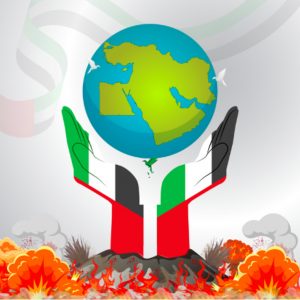

Mohammed Abdulaziz Khadim

Ahmed Almehairi
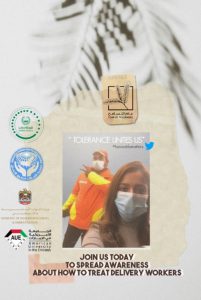

Sarah Fahmi Othman Al-Sagheer

Rozan Ahmed H AlGhannam

Jomana Qassem Bahman Amiri
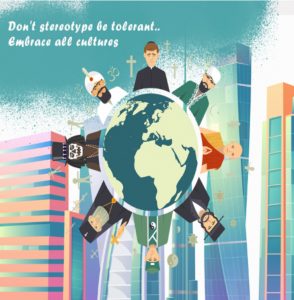

Shaima Jaffar Qambar Jaffar AlAli

Rami Refat Attia Safi
